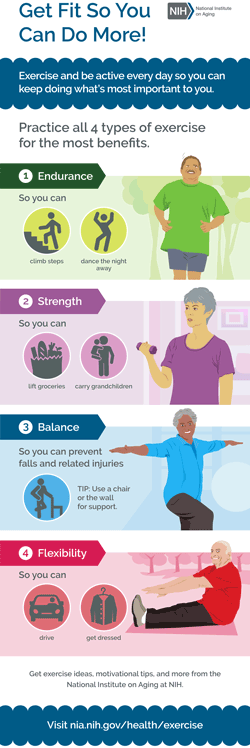Winter Workouts: Tips for Being Active in Cold Winter Months
by Madison Burgard
November 2022
As the days get shorter, the temperatures drop, and the snow begins to build up, the last thing North Dakotans want to do is get up and exercise. However, it is important to continue to stay active even during the winter. Why? There are many benefits of exercise: it is good for the heart, helps to lower blood pressure, and decreases feelings of worry and sadness. It has even been proven to help decrease chronic pain. Studies have shown that walking as little as five to ten minutes after meals can help decrease the chances of getting diabetes. Winter exercise also helps keep the body in shape for spring and summer hobbies or work-related physical activities.
The Centers for Disease Control and Prevention recommends 150 minutes (about 2 and a half hours) of exercise a week, which comes to about 30 minutes a day, five days a week. Even doing some sort of exercise for 10 to 15 minutes a day – either inside or out – may be doable for many people living in wintry Adams County.

exercise: endurance, strength,
balance, and flexibility.
Another way to think about exercise is choosing activities from four categories suggested by researchers at the National Institute of Aging: endurance, strength, balance, and flexibility. Endurance exercises benefit heart and lung health and can include winter activities such as shoveling snow. Another indoor activity is to go up and down stairs. For people who have a large shed or garage, walking the perimeter can be a good option to get the heart rate up for a sustained period. Exercise can even include fun activities such as dancing inside to favorite music.
Exercises that focus on building strength are important as they promote independence and make routine activities easier such as carrying groceries and getting in and out of chairs. An example of an exercise in this category is squats or push-ups. These exercises are more effective with repetition, like repeating ten times, then resting for a minute.
Balance and flexibility exercises can benefit aging brains, muscles, and joints. Improving balance can also help prevent falls while improving flexibility can prevent muscle and joint stiffness. Standing on one foot for a few seconds or walking heel to toe across a room can improve balance. Stretching exercises promote flexibility. For example, one easy exercise to do on a chilly winter night while watching TV is to take one arm across the chest and reach the opposite shoulder with the other hand and hold for ten seconds.
These suggestions are evidence that even during the winter months, there are plenty of ways to stay active – and most of them do not even involve leaving the house, using special equipment, going to the gym, or even using the internet. Talk to your doctor for more information. Often, they can also help print out some exercises that would be beneficial for specific health needs or make a referral to a physical therapist.
This article also appeared in the December 29, 2022 issue of the Adams County Record.
About the Author
 Madison Burgard is a third-year
medical student at the University of North Dakota (UND)
School of Medicine & Health Sciences. She was selected as
the Hettinger participant for the school's ROME program,
or Rural Opportunities in Medical Education. Because the
program includes teaching student doctors about the
importance of how rural newspapers can deliver health
information, she has written this column for her ROME
community. The information is not for diagnosis or
treatment and should not be used in place of previous
medical advice provided by a licensed practitioner.
Madison Burgard is a third-year
medical student at the University of North Dakota (UND)
School of Medicine & Health Sciences. She was selected as
the Hettinger participant for the school's ROME program,
or Rural Opportunities in Medical Education. Because the
program includes teaching student doctors about the
importance of how rural newspapers can deliver health
information, she has written this column for her ROME
community. The information is not for diagnosis or
treatment and should not be used in place of previous
medical advice provided by a licensed practitioner.
